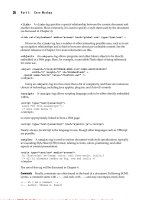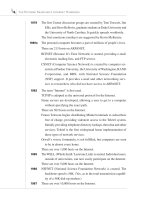THE FRACTAL STRUCTURE OF DATA REFERENCE- P2 pdf
Bạn đang xem bản rút gọn của tài liệu. Xem và tải ngay bản đầy đủ của tài liệu tại đây (45.43 KB, 5 trang )
Contents
ix
List of Figures
List of Tables xiii
Preface xv
Acknowledgments xix
1. HIERARCHICAL REUSE MODEL 1
1. Background 2
2. Motivation 3
3. Model Definition 6
4. Visits to Memory 11
5. Two Levels of Cache 25
2. HIERARCHICAL REUSE DAEMON 35
1. Desired Behavior 35
2. Definition of the Synthetic Application 37
3. Analysis of the Synthetic Application 37
4. Empirical Behavior 40
43
3. USE OF MEMORY BY MULTIPLE WORKLOADS
1. Cache Use by Application 44
2. Analysis of the Working Hypothesis 47
4. USE OF MEMORY AT THE I/O INTERFACE
51
1. Simulation using Time
-
in
-
Cache 52
3. Expectations for Memory Interaction 56
5. MEMORY MANAGEMENT IN AN LRU CACHE
61
1. The Case for LRU 62
2. Generalized LRU 67
6. FREE SPACE COLLECTION IN A LOG
71
2. A Case Study 53
1. The Life Cycle of Logged Data 74
viii
THE FRACTAL STRUCTURE OF DATA REFERENCE
2. First
-
Cut Performance Estimate 75
3. Impact of Transient Data Access 78
4. History Dependent Collection 80
85
1. Transient Access Revisited 87
2. Periods up to 24 hours 91
3. Periods up to One Month 96
8. HIERARCHICAL STORAGE MANAGEMENT 103
1. Simple Model 104
113
1. Deployable Applications Model 115
2. Average Storage Intensity 117
4. Conclusion 124
7. TRANSIENT AND PERSISTENT DATA ACCESS
2. A Case Study 110
9. DISK APPLICATIONS: A STATISTICAL VIEW
3. Disk Performance Requirements 121
127
131
References
Index
List of Figures
1.1
Pattern of requests to an individual track. The vertical
axis acts as a “zoom”, to separate groups of references
that are too closely spaced to distinguish along a single
time line. 6
1.2 Distribution of track interarrival times. Each curve
shows a user or system storage pool at one of 11 sur
-
1.3 Distribution of page frame interarrival times. Each
curve shows a user or system storage pool at one of 11
1.4 VM user storage pools: cache performance as a function
of average cache residency time.
1.5 VM system storage pools: cache performance as a func
-
1.6 DB2 storage pools: cache performance as a function of
1.7 CICS storage pools: cache performance as a function of
1.8
IM
S
storage pools: cache performance as a function of
1.9 TSO storage pools: cache performance as a function of
1.10 OS/390 system storage pools: cache performance as a
21
1.1 1
DB2 storage pools: distribution of track interarrival times. 28
1.12 DB2 storage pools: distribution of record interarrival times. 28
1.13
C
I
C
S
storage pools: distribution of track interarrival times. 29
1.14
C
I
C
S
storage pools: distribution of record interarrival times. 29
1.15 IMS storage pools: distribution of track interarrival times. 30
veyed VM installations. 10
surveyed VM installations. 11
18
19
tion of average cache residency time.
average cache residency time. 19
average cache residency time. 20
average cache residency time. 20
average cache residency time. 21
function of average cache residency time.
x THE FRACTAL STRUCTURE OF DATA REFERENCE
1.16 IMS storage pools: distribution of record interarrival times. 30
1.17 TSO storage pools: distribution of track interarrival times. 31
1.18 TSO storage pools: distribution of record interarrival times. 3 1
1.19 OS/390 system storage pools: distribution of track inter
-
arrival times. 32
1.20 OS/390 system storage pools: distribution of record in
-
terarrival times. 32
2.1 Distribution of interarrival times for a synthetic appli
-
cation running at one request per second, with v = 0.44
(corresponding to θ = 0.15).
Distribution of interarrival times for a synthetic appli
-
cation running at one request per second, with v = 0.40
(corresponding to θ = 0.25).
Distribution of interarrival times for a synthetic appli
-
cation running at one request per second, with v = 0.34
(corresponding to θ = 0.35).
40
2.2
41
2.3
41
57
4.1
6.2
7.1
7.2
7.3
7.4
7.5
7.6
7.7
7.8
7.9
7.10
7.1 1
7.12
7.13
7.14
7.15
Tradeoff of memory above and below the I/O interface.
6.1 Overview of free space collection results. 73
Distribution of time between track updates, for the user
and system storage pools also presented in Figure 1.2. 78
Distribution of probability density for the metric P:
track image granularity. 89
Distribution of probability density for the metric P:
cylinder image granularity. 90
Distribution of probability density for the metric P: file
granularity, weighted by storage. 90
Active track images as a function of window size. 92
Active cylinder images as a function of window size. 92
93
93
94
94
Requests to persistent track images as a function of
window size. 95
Requests to persistent cylinder images as a function of
window size. 95
Requests to persistent files as a function of window size. 96
Distribution of file interarrival times, based upon open
Average active file storage over periods up to one month. 98
Storage belonging to persistent files, over periods up to
one month. 100
Active file storage as a function of window size.
Persistent track images as a function of window size.
Persistent cylinder images as a function of window size.
Persistent file storage as a function of window size.
requests. 97
List of Figures xi
100
7.16
9.1
Requests to persistent files, over periods up
to
one month.
Behavior of the average storage intensity function, for
various α and β. 119
8.1 Contour plot of the simulation results. 111
9.2 Approximate trends in access density and storage cost. 121









